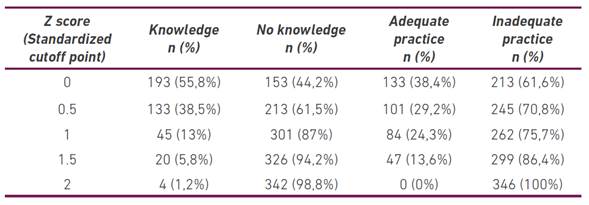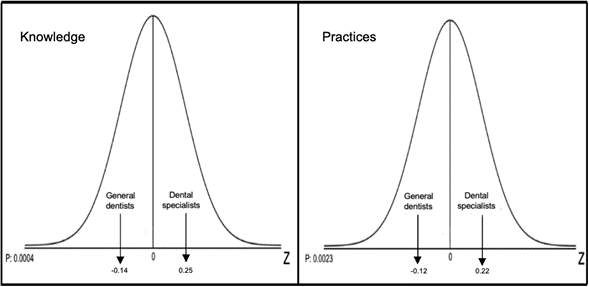Introduction
Bisphosphonates are a group of medications that are potent inhibitors of bone reabsorption and are used in the treatment of osteogenesis imperfecta, osteopenia, osteoporosis, Paget’s disease of the bone, multiple myeloma, metastatic bone disease, and oncologic complications such as hypercalcemia 1. In 2002, the first cases of bisphosphonate-induced osteonecrosis of the jaws (BIONJ) were reported by Marx & Stern, and this pathologic condition was defined as “the exposure of bone in the maxilla or mandible that persists for more than 8 weeks in patients that had or are under treatment with bisphosphonates, and that have no previous history of maxillary radiotherapy” 2. These regions of exposed bone may remain asymptomatic during prolonged periods of time (weeks, months, or years), and may become symptomatic with inflammation of surrounding tissues. Before patients develop clinically detectable evidence of necrosis BIONJ may present signs and symptoms such as pain, tooth mobility, mucosal inflammation, erythema, ulceration, paresthesia and even anesthesia of the mandibular nerve 3.
Among the predisposing factors for BIONJ are diseases that affect the circulatory system, cellular metabolism, oxygenation, and immune response, as well as chronic use of corticosteroids such as methotrexate, thalidomide, and cigarette smoking 4. Incidence of BIONJ in patients receiving intravenous bisphosphonate (IV-BP) therapy has been estimated to be between 0.8 and 12%, and of 0.01% and 0.04% for those receiving oral bisphosphonate (OBP) therapy. Bisphosphonate-induced osteonecrosis of the jaws is more frequently found in the mandible (65%) than in the maxilla (28.4%) 5,6.
In order to provide proper dental treatment to patients who are under bisphosphonate therapy it is of critical importance that dental providers perform a good anamnesis, a comprehensive clinical examination and use diagnostic tests such as periapical/panoramic x-rays, and fasting serum C-terminal telopeptide (CTX) to asses for possible risk factors for BIONJ. This is relevant since scientific evidence has reported there are dentists that refuse-to treat patients with history of bisphosphonate therapy due to lack of knowledge of this condition 2,4; while this has been explored in other parts of the world, in Colombia there is currently no available reports regarding this behavior. Therefore, the aim of this study was to explore whether the level of knowledge, attitude, and practices of Colombian’s general and specialist dentists regarding BIONJ was comparable. The null hypothesis was defined as no differences between the level of knowledge, attitude and practices between Colombian’s general and specialist dentists.
Materials and methods
The research was approved by the Institutional Ethics Board at CES University (Medellin, Antioquia, Colombia) (minute #115, November 7, 2017). This was an explanatory (analytical), observational cross-sectional study based on objective measurements of knowledge, attitudes and practices of general and dental specialists in Colombia who voluntarily accepted to complete the survey.
Sample was collected by taking as reference the variable of knowing the term BIONJ, assuming a proportion of 58% as “proper-knowledge” in the dental specialists group and of 43% among general dentists. Difference was established to be at 15% with a confidence interval of 95%, 80% power and a 1:2 ratio between groups. Thus, a sample of 114 dental specialists and 228 general dentists was calculated using the sampling module of Epidat version 4.2 software (Xunta de Galicia Ministry of Health, European Regional Development Fund, Santiago de Compostela, España).
A pilot study was conducted on 30 general dentists and dental specialists at CES Sabaneta Clinic (Medellin, Antioquia, Colombia) with the goal to evaluate clarity and apparent validity of the questionnaire, response time, level of understanding, and analysis viability in order to adjust the instrument. Subsequently, paper and online (www.encuestafacil.com) surveys containing 19 questions on 3 domains (knowledge, attitudes, and practices) in relation to BIONJ were administered to general dentists and dental specialists in Colombia between January and December 2018. Only completely filled out surveys, both in paper or online, were included in the statistical analysis.
In this study sampling was done by convenience, i.e. those dentists that accepted to complete the survey; random selection of participants was not performed. In addition, no confusion variables were considered since the only classification variable used was professional training. All data were collected and stored in Microsoft Excel (version 15.38-2017, Microsoft Corp, Redmond WA, USA) spreadsheets. Statistical analysis was performed using Stata software (version 12.1, Stat Corp., Lakeway Drive, TX, USA).
Initially internal consistency of the survey was assessed by the psychometric Cronbach’s alpha (Cα) test, for which values ≥ 0.700 were considered as acceptable 7. For the descriptive analysis Z values were calculated for each of the questions in the knowledge and practices domains, determining an acceptable score level for knowledge and practices. Finally, a Student’s t-test was used to determine the statistical significance (P < 0.05) between knowledge and practices of general and specialist dentists.
Results
A total of 342 dentists, of which 114 were specialists and 228 general dentists in Colombia participated in this study. Participants completed a survey that included 19 questions on knowledge, attitude and practices in relation to BIONJ. The majority of participants (87.72%) reported that they knew the term, specifically 107 (93.85%) of specialists and 193 (84.65%) of general dentists. Cronbach’s alfa was used to measure internal consistency of the instrument (Table 1). It is important to highlight that domain 2 (attitudes) presented low Cα value (< 0.700) indicating a weak relationship among questions in this domain, therefore was eliminated from the analysis (7). The level of knowledge and practices of general and dental specialist dentists of BIONJ according to a Z-score, where Z=0 was defined as adequate is shown in Table 2.
In regards to knowledge Z-scores of general and specialist dentists were -0.14 and 0.25 respectively, this difference was statistically significant (p= 0.0004) (Fig. 1). Similarly, Z-scores regarding practices were of -0.12 and 0.22 for general and specialist dentists, this difference was also found to be statistically significant (p= 0.0023) (Fig. 1).
Table 1 Internal consistency of the instrument and its domains according to all responses and only correct responses provided by specialized and general dentists in Colombia, 2018.

Table 2 Percent of general and dental specialists with adequate knowledge and practices according to standardized cutoff points of the knowledge, attitude and practices related to BIONJ survey carried out in 2018.

Discussion
Worldwide the number of reports of BIONJ cases has been increasing over the past decades. In Japan a total of 28 cases were reported in 2006, of which 17 (60.7%) were associated to IV bisphosphonates use and 7 (32.1%) to oral bisphosphonates 8. On the other hand, in the United States and Australia around 95% of BIONJ were associated with IV bisphosphonates and 5% with oral bisphosphonates 2. Although to date in Colombia there are no case reports of BIONJ, a number of unreported or misdiagnosed cases may exist due to the wide availability of bisphosphonates for the treatment of osteoporosis/osteopenia, many of them sold without a prescription, in addition to the lack of knowledge that dentists or physicians may have regarding the association of these medications with osteonecrosis of the jaws. Therefore, the aim of this study was to explore by means of a survey, the attitudes, knowledge and practices of general and specialist dentists in relation to BIONJ. This was relevant to investigate since dentists are directly involved in favoring or not the development of this pathological condition by patients with predisposing factors once dental treatment has been initiated. In addition, while this research didn’t conducted an epidemiological survey on BIONJ in Colombia, the findings may be relevant as an internal validation construct for the design of future studies 1.
Regarding knowledge and practices, the overall rate herein reported was of 55.8% and 38.4% of participants respectively according to a Z-score value = 0, which was used as cutoff point to determine whether or not the attribute existed. In this matter, it is important to point out that the cutoff was established by a statistical calculation that was mainly arbitrary; however previous reports indicate that it must be done this way when there are no previous points of reference to validate such cutoff point 9. To the authors knowledge, there are no previous studies addressing attitudes or practices in regards to BIONJ. However regarding knowledge of BIONJ it was able to compare this results with those from a previous study from Brazil in dental students and dentists that reported a level of knowledge of 43.4%, which is slightly lower than the overall rate of 55.8% from this study 10. While differences in professional training between participants included in both studies (dental students vs general and specialist dentists) may explain the differences in level of BIONJ knowledge, it is important to highlight that BIONJ is a highly relevant global oral health issue and great efforts are being made by dental schools, scientific societies, high impact factor journals, and the internet to make scientific information widely available to students as well as dentists 4,10. The finding shows that although 65.3% of Colombian specialist dentists have a good knowledge about BIONJ, most are not comfortable performing oral surgery in patients taking BPs. Those with higher knowledge scores suggested greater educational efforts to spread knowledge among dentists about BIONJ.
In this respect, in Canada the main source of information used for the decision-making process of BIONJ patient management by dentists was mainly scientific papers (56%), short continuing education courses (43%), conferences (34%), guidelines approved by the American Association of Oral and Maxillofacial Surgeons (AAOMS) since 2009 (23.8%) and academic training (20%) 11. These findings may support the results of the present study since there is currently no clinical guideline based on scientific evidence available in Colombia for dentists to follow for the management of patients at risk of BIONJ; other sources of information may have been used for this purpose. In addition, based on the findings that indicated 65.3% and 44.6% adequate knowledge and practices respectively in dental specialists and 50.7% and 35.1% in general dentists, it could be considered that dental specialists use those sources of information more frequently than general dentists.
Furthermore, differences among clinical specialties of participants within the group of dental specialists could also have influenced the results. However, and since these were not considered in the initial study design they were not quantified. Interestingly, other studies have reported that maxillofacial surgeons display a greater level of knowledge and better practices regarding BIONJ compared to other specialists, this was mainly attributed to the greater number of BIONJ cases usually referred to these specialists 12.
On the other hand, the referral of a patient at risk for BIONJ to a dental specialist has been considered as a standard of good clinical practice 4,11. In this regard, this study found that upon identification of risk factors for the development of this condition during medical interview, 54.36% of dentists (general/specialized) referred patients to other health professionals with greater knowledge or expertise on BIONJ. This finding is comparable to the 50.3% previously reported by other authors 11. While there are currently several clinical guidelines for the management of BIONJ prevention of this condition also plays an important role. Patients at risk of developing BIONJ can be identified through a good medical interview complemented by a thorough dental exam, in which the state of oral health of patients before, during and after treatment with bisphosphonates is prioritized 12-14.
Based on our results, the null hypothesis was rejected as the level of knowledge and practices in relation to BIONJ was higher in specialist than in general dentists. Interestingly, this is the first study in Colombia that establishes a frame of reference for future studies evaluating other aspects of BIONJ in this population.















